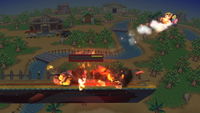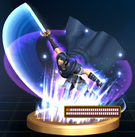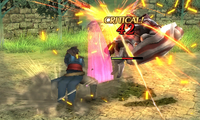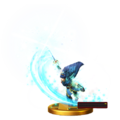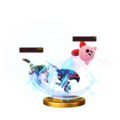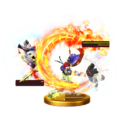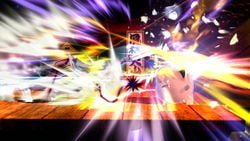Critical Hit: Difference between revisions
m (→Origin) |
No edit summary Tag: Mobile edit |
||
| Line 82: | Line 82: | ||
*Roy's Critical Hit actually does less damage and knockback than his fully charged [[Flare Blade]]. | *Roy's Critical Hit actually does less damage and knockback than his fully charged [[Flare Blade]]. | ||
*When Roy performs the Final Smash, his sheath appears during the attack but disappears when the attack is finished. | *When Roy performs the Final Smash, his sheath appears during the attack but disappears when the attack is finished. | ||
*After | *After activating Roy's Critical Hit in the air, he performs a backflip before landing similar to his critical hit animation from ''Fire Emblem: The Binding Blade''. | ||
{{Multiple Special Moves|Marth|Lucina}}{{Special Moves|char=Roy}} | {{Multiple Special Moves|Marth|Lucina}}{{Special Moves|char=Roy}} | ||
Revision as of 13:22, April 25, 2016
| Critical Hit | |
|---|---|
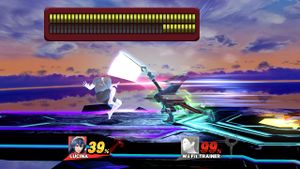 Lucina using Critical Hit in Super Smash Bros. for Wii U | |
| User | Marth Lucina Roy |
| Universe | Fire Emblem |
| Article on Fire Emblem Wiki | Critical hit |
| “ | Unleash a full-powered attack to launch foes. | ” |
| —Super Smash Bros. for Nintendo 3DS foldout description | ||
Critical Hit (必殺の一撃, Sure-Killing Blow) is Marth's Final Smash in Super Smash Bros. Brawl and Marth, Lucina, and Roy's Final Smash in Super Smash Bros. 4. It involves the character delivering an immensely powerful slash that deals a devastating amount of knockback, more than enough to one-hit-KO if directly in the line of sight of a blast line (with the exception of Roy's version). If it hits, a HP gauge from Fire Emblem is displayed alongside each hit character, which starts at full and quickly drops to zero.
Marth & Lucina
Marth or Lucina raise their respective swords in the air, where it catches the light and shimmers brightly (this slows down time by a slight amount), before dashing forward with blazing speed to catch any unfortunate opponents with an incredibly high knockback slash.
It is by far the strongest Final Smash in Brawl and Smash 4, and its power and damage also make it one of the strongest attacks in all of the games. It deals 62% damage in Brawl (60% base plus 2% fresh) and deals more than enough knockback to KO any character at 0% under most normal circumstances. The power of this move is hampered somewhat by its larger time frame in which to perform a dodge (the time during which Marth raises his sword), though it is still relatively fast.
Until the attack animation completely ends, the entire sword carries the move's hitbox, meaning that the attack can also hit anyone directly behind Marth when Marth swings his sword; because the attack itself gives such an incredible amount of freeze frames, it is possible for a fighter to walk into Marth's sword once it hits another opponent and still be given a OHKO, even after half a second. On the ground, the attack will follow the platform's contours, and the move will end without Marth swinging if he reaches the edge. Missing with this attack on the ground on a walk-off stage, or in the air without any intervening terrain, usually results in a self-destruct, as the dash Marth performs during the move is approximately the same distance as the width of the largest area available in the Stage Builder. However, this can be avoided by pressing an attack button, which will stop the dash and trigger the strike immediately. The distance the Final Smash gives can let Marth/Lucina use it as an extremely good recovery move if needed, as the move gives an incredible amount of horizontal distance.
Since the move is nothing more than a single hit, launch resistance such as that gained from using Aether can be used to survive, providing good timing. Of course, this will not stop the target from taking the move's full damage.
Despite its ridiculous power, Critical Hit has earned the reputation of being one of the most predictable and avoidable Final Smashes due to its slow startup time and introduction sequence, which gives all other players in range the chance to completely dodge the move by air dodging, sidestepping, or simply moving away. Landing the blow is hence easiest against opponents suffering from ending lag or helplessness, or who are simply unaware.
This attack has such immense knockback that is possible to KO someone else by knocking someone hit by the attack into someone else.
While Marth does not say anything while performing this move (apart from a grunt), Lucina in Super Smash Bros. 4 shouts "Time to change fate!" (運命を変えます!, I will change fate!).
Roy
Roy's Critical Hit involves him standing in place while spinning the Sword of Seals in a backwards arc around him with two hands. It then flashes with light (similar to Marth and Lucina's version when it starts up) before Roy swings his sword violently downwards, creating a massive fiery explosion in front of him before he sheaths his sword (a purely aesthetic animation that ends in a second). When he finishes the Final Smash in the air, he leaps a small distance upward. When he jumps after the Final Smash, it's possible to double jump unless Roy used up his second jump prior to activating it. The flaming slash deals 40%, and anyone hit by it is sent flying with high knockback, although the slash is not a OHKO unlike Marth/Lucina's version which can KO at any percentage, and deals considerably less knockback at 0%, making it unable to KO fresh stocks (starting to KO only at 40%).
Of note is that the circular swing Roy performs when starting the move carries a hitbox until it ends: the sword deals multiple 1% hits while it moves, and the opponent is more vulnerable to getting trapped by the swing if they are behind Roy since he begins the move from his back. A total of 11% can be dealt by the startup alone, and the final hit positions trapped opponents in front of Roy, making them vulnerable to the brunt of the finishing blow.
Because Roy's Critical Hit does not involve him moving forwards, the range of his version is severely lower than Marth/Lucina's. The hitbox of the flaming slash also does not cover below Roy, making it possible to miss if Roy jumps and unleashes the move. However, the explosion itself has a large hitbox, and because the start of his Critical Hit can trap opponents into the final blow, it is more reliable at connecting and far less predictable than Marth/Lucina's Critical Hit, which has a highly predictable startup and a somewhat small hitbox; it even has a decently quick startup and can combo into Roy's throws at low percents, which can almost guarantee a KO.
Similar to Marth/Lucina's, a purely aesthetic health bar appears for every victim sent flying, showing them dropping from full health to zero.
Trophy descriptions
- Critical Hit (Brawl)
- Marth's Final Smash. He thrusts his sword skyward, then rushes to meet his targeted enemy with furious speed. The blow he strikes is so powerful that his foe is instantly launched off the screen. As in Fire Emblem, a window appears that shows the character's hit points dropping rapidly to zero--but this is just for effect. Smash Bros. does not use a hit-point system.
- Critical Hit (Marth)
Marth raises his Exalted Falchion to the sky and then rushes forward to deal an incredibly powerful blow, almost certainly KO'ing anyone and everyone who gets hit! When it's used in the air, he'll fly forward a certain distance. On the ground, however, he'll only dash to the edge of the platform he's standing on.
Marth raises his Exalted Falchion to the sky, then rushes forwards to deal an incredibly powerful blow, almost certainly KOing anyone and everyone who gets hit! When used in the air, he'll fly forwards a set distance, but on the ground, he'll only dash up to the edge of the platform he's standing on.
- Critical Hit (Lucina)
In Lucina's Final Smash, she raises her sword high before dashing swiftly forward to deliver a deadly blow to whomever she makes contact with first. Even if their damage is low, this strike is powerful enough to take out foes in a single hit. Just make sure you don't dash off the stage when you use it in midair!
In Lucina's Final Smash, she raises her sword high, then dashes swiftly forwards to deliver a deadly blow to whoever stands in her way. Even if their damage is low, this strike is powerful enough to take them out in a single hit. Just be careful not to dash off the stage if you use it in mid-air!
- Critical Hit (Roy)
- For Roy’s Final Smash, he traps enemies in a circular swing of the blade, brings it up behind him, and then, in a blast of fire, brings the blade down for a powerful finisher! The downward attack is powerful on its own but doesn’t have much range, so make sure you’re close enough to hit your enemies with the full combo and really seal their fate!
Origin
The critical hit is a staple feature of the Fire Emblem game series, which inflicts three times the standard damage if performed, accompanied by a unique attack animation. The animation for this Final Smash was likely inspired by the critical hit animations of the various Lords in the series' past; Marth's Critical Hit animation is loosely based on his Critical Hit animation from the first Fire Emblem game, while Roy's Critical Hit animation is based on his Critical Hit animation from Fire Emblem: The Binding Blade, provided he has the Sword of Seals equipped (this also applies to the airborne version's recovery flip, which is a nod to the very same one Roy does when he sheaths back his sword).
The gauge that appears represents the Hit Point system used in the series. In Brawl, it has a graphical style similar to those of Fire Emblem: Mystery of the Emblem, whereas in Super Smash Bros. 4, the gauge seen in Marth's, Lucina's and Roy's Final Smashes resembles the HP gauge used in Fire Emblem: Awakening.
Gallery
Critical Hit in Brawl
Marth's Critical Hit in Super Smash Bros. for Wii U.
Lucina's Critical Hit while dashing in Super Smash Bros. for Nintendo 3DS.
Lucina's Critical Hit in Super Smash Bros. for Wii U.
Trivia
- The health gauge shown has 60 HP units. In Fire Emblem: Shadow Dragon and the Blade of Light and Fire Emblem: Mystery of the Emblem, both of which star Marth, enemies could have up to 60 HP. In the remakes of those games, Fire Emblem: Shadow Dragon and Fire Emblem: New Mystery of the Emblem, normal units can have a maximum HP of 60. Marth and Lucina deal 60% damage with Critical Hit in Super Smash Bros..
- Marth's Final Smash is able to outrun the cars on Big Blue. In fact, it is even faster than Sonic wearing a Bunny Hood (who can also outrun the cars on Big Blue). However, the attack's ending lag will probably cause Marth to SD using it.
- The sheer amount of knockback and damage Marth/Lucina's Critical Hit deals is so immense that even permanent metal characters fought in Classic Mode or Special Smash will instantly be forced back into their non-metal selves before being KO'd.
- Critical Hit is one of the only Final Smashes shared by multiple characters, along with Landmaster, PK Starstorm, Light Arrow, and Triforce Slash.
- Of these, Critical Hit is the only one not shared by multiple characters in Brawl.
- Roy's Critical Hit actually does less damage and knockback than his fully charged Flare Blade.
- When Roy performs the Final Smash, his sheath appears during the attack but disappears when the attack is finished.
- After activating Roy's Critical Hit in the air, he performs a backflip before landing similar to his critical hit animation from Fire Emblem: The Binding Blade.
